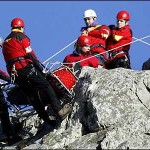 Mountaineering is one of the most stressful environments for any team to operate in, so it’s perhaps not surprising that it is been the petri dish for management researchers.
Mountaineering is one of the most stressful environments for any team to operate in, so it’s perhaps not surprising that it is been the petri dish for management researchers.
One such study was covered last year and looked at hierarchies amongst rock climbers. The paper suggests that a distinct and clear hierarchy can provide teams with coordination, organization and a reduction in conflict during high pressure situations.
“These processes explain why a strong hierarchy can help expeditions reach the top of the mountain: like the symphonic movement of a beehive, hierarchy helps the group become more than the sum of its parts,” the authors say.
The downside of hierarchy
Of course, it isn’t all rosy, and the authors are at pains to point out that hierarchy can also foster a culture of inhibition where team members are forced to follow the herd rather than speak up.
This was critical in a climbing environment where people are forced to react and respond to the rapidly changing environment. Being unable to speak up in such an environment can lead to catastrophe.
A second study, by a team of researchers from the Haas School of Business examined this conformity in more detail. They also examined Himalayan climbers and found a blurred effect whereby the individual skills and knowledge of climbers was superseded by groupthink.
“This blurring effect, which is cognitive in nature, is among the most profound I’ve seen in my research career. It is easily manipulated and has dramatic consequences. By simply asking people in a diverse group to focus on commonalities within the group, they appear to be unable to also focus on the attributes that differentiate group members from one another. It is like asking people to focus on the forest, which seems to preclude them from also focusing on the trees,” the authors say.
The climbers of the Himalayas were chosen because, unlike most teams, they have a singular objective, which therefore made it easier to compare performance between teams. The study analyzed 40,000 climbers from 5,000 different expeditions, and found that the diversity of the team (as represented by their nationalities) often blurred and was discounted. This in turn made it more likely that teams would succeed in reaching the summit.
Thought diversity
When the diversity was more important however, ie when the skills of the climbers differed, this blurring had more deadly consequences.
“They ‘blur up,’ pushing each other more because they fail to recognize that novices have less capability, and consequently, more people died,” the authors say.
These findings were later replicated in a laboratory setting, with collectivistic thinking leading to poorer decision making.
Obviously our workplaces aren’t akin to climbing some of the highest mountains in the world, but the authors suggest that it should remind us that cooperation amongst the team is not always best. The importance of thought diversity is something I’ve touched on several times before and this reminds us of its importance.
As a slight caveat, a paper published last year examined the coordination costs involved with a diverse team. There is a point whereby pulling together a diverse team becomes more costly than the benefits you gain from that diversity. As with most things therefore, it’s a balancing act you will need to strike to ensure your team is effective.